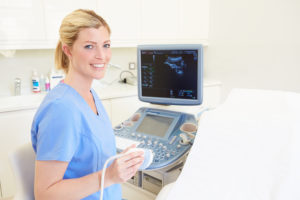Are you fascinated by the advances in 21st Century medicine that allow your health providers to see real-time pictures of blood flow in your arteries or watching a baby move? Every day, Ultrasound Sonographers help improve the lives of those around them by providing critical medical and administrative duties in medical offices. Learn what ultrasound equipment looks like, what a diagnostic medical ultrasound sonographer can do after obtaining a degree and the different specialties of an ultrasound sonographer.
What Does the Ultrasound Equipment Look Like?
Ultrasound scanners include a console, a video display screen and a transducer used to do the scanning. The transducer is a small hand-held device attached by a cord. The tra nsducer sends out high-frequency sound waves in the body and then listens for the returning echoes from the tissue of the body. The ultrasound image is visible on the video screen and is created based on the amplitude, frequency and the time it takes for the ultrasound signal to return for the area within the patient examined by the transducer.
nsducer sends out high-frequency sound waves in the body and then listens for the returning echoes from the tissue of the body. The ultrasound image is visible on the video screen and is created based on the amplitude, frequency and the time it takes for the ultrasound signal to return for the area within the patient examined by the transducer.
What Does a Diagnostic Medical Ultrasound Sonographer Do?
Diagnostic medical ultrasound sonographers operate special imaging equipment to create images or conduct tests. The images and test results help physicians assess and diagnose medical conditions. Some diagnostic medical ultrasound sonographers assist physicians and surgeons during surgical procedures. Diagnostic medical ultrasound sonographers typically do the following:
- Prepare patients for Ultrasound procedures
- Take a patient’s medical history and answer any questions about the Ultrasound procedure
- Prepare and maintain diagnostic imaging equipment
- Operate equipment to obtain diagnostic images
- Review images and test results to check for quality and adequate coverage of the areas
- Understand what an abnormal image is compared to a normal image
- Analyze diagnostic information to provide a summary of findings for the doctor
- Record findings and keep track of patients’ records
General Diagnostic Medical Ultrasound Sonographer
General diagnostic medical ultrasound sonographers work in an out-patient care center or physician’s office. They assist a physician in out-patient ultrasound procedures, prepare diagnostic imaging equipment and analyze ultrasounds to convey information to the physician. Diagnostic medical ultrasound sonographers are not licensed to diagnose a patient based on an ultrasound and they work closely with the physician to deliver information about the ultrasound to the patient.
OB/GYN Sonographers
The OB/GYN sonographer works closely with patients and new mothers. Upon completion of the sonogram, the OB/GYN sonographer will share any abnormalities with a physician. The OB/GYN sonographer also handles the following duties:
- Reviews patients’ medical history
- Explains specific medical and sonography procedures to patients
- Positions patients for optimal imaging
- Observes and measures the fetus
- Operates ultrasound equipment
The OB sonographer uses the ultrasound to examine the fetus of a pregnant woman. The ultrasound examines the position of the fetus, helps diagnose any congenital abnormalities, and determines how many fetuses are in the womb (twins, triplets, etc.). The OB ultrasound can be used to measure fetal body measurements to see if the fetus’ growth is progressing normally. The measurements can also be used to assess the gestational age of the fetus.
The GYN sonographer evaluates organs found within the female pelvic region. The GYN sonogram can help identify issues including ovarian cysts, uterine fibroids and any ovarian masses.
Cardiovascular Sonographers
Works alongside a physician, using ultrasound imaging to evaluate different aspects of the heart including chamber size, valve function and blood flow. The cardiovascular sonographer reviews patient files in order to recognize any abnormalities in the sonogram.
The cardiovascular sonographer needs to have good communication skills to properly convey information to the physician about the completed sonogram. The cardiovascular sonographer should also have good bedside manner for dealing with patients.
The skills of a successful cardiovascular sonographer include flexibility, enthusiasm and confidence. A cardiovascular sonographer needs to be flexible to take on any aspects of the cardiovascular ultrasound. They must be enthusiastic to learn new uses of the ultrasound. The cardiovascular sonographer must have the confidence to interpret the images properly and pass on the relevant information for the physician to make an accurate diagnosis.
Breast Ultrasound Technician
Uses specialized frequencies and transducers to create diagnostic images of breast tissue. The breast ultrasound is usually used in conjunction with a mammogram to check any abnormalities from a mammogram. Like a mammogram, breast ultrasounds are used to see whether a breast lump is filled with fluid or is a solid lump. A physician may choose to perform a biopsy with the help of the breast ultrasound. The breast ultrasound provides real-time images to guide the physician during the biopsy.
Musculoskeletal Sonography
Uses sound waves to produce images of muscles, tendons, ligaments and joints. The musculoskeletal ultrasound is used to diagnose sprains, strains, tears and other soft tissue conditions. Common uses for the musculoskeletal ultrasound are diagnoses of tendon tears and tendinitis of the rotator cuff. It can also be used to diagnose muscle tears, masses or fluid collections. Those with rheumatoid arthritis can be given early warning with the use of the ultrasound. Lastly, the musculoskeletal ultrasound can help diagnose benign and malignant soft tissue tumors.
Does a degree in Diagnostic Medical Ultrasound Sonography interest you? Meridian College offers hands-on Diagnostic Medical Ultrasound training from experienced faculty who know how to prepare you for the daily challenges you’ll face on the job. From assisting doctors with patients to important administrative tasks, our experienced teachers will train you for a rewarding new career. Contact us to learn more about becoming a diagnostic medical ultrasound sonographer.